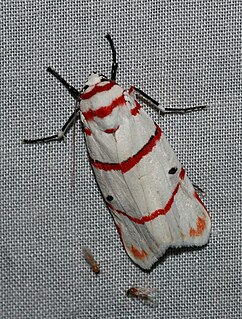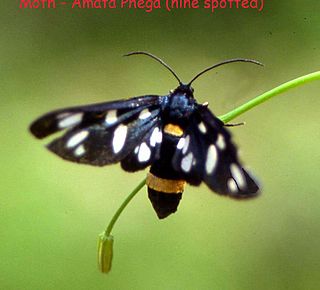
Hypena is a genus of moths in the family Erebidae. It was first described by Franz von Paula Schrank in 1802. These non-migratory moths overwinter as pupae and almost never come to bait as adults.

Omiodes is a moth genus in the family Crambidae. Several species are endemic to Hawaii.

Cyana is a genus of moths in the family Erebidae. Species are well distributed in Africa, Madagascar, China, India, Sri Lanka, Myanmar, Sumatra, Java and Borneo. The genus was erected by Francis Walker in 1854.

Eressa is a genus of moths in the family Erebidae. The genus was erected by Francis Walker in 1854.
Eressa angustipenna, the black-headed wasp moth, is a moth of the family Erebidae. It was described by Thomas Pennington Lucas in 1890. It is found in Australia, as well as the Philippines.
Eressa aperiens is a moth of the family Erebidae. It was described by Francis Walker in 1865. It is found in India.

Eressa confinis is a moth of the family Erebidae. It was described by Francis Walker in 1854. It is found in India, Bhutan, Sri Lanka, Myanmar, Taiwan and China.
Eressa eressoides is a moth of the family Erebidae. It was described by George Hampson in 1893. It is found in Myanmar.
Eressa furva is a moth of the family Erebidae. It was described by George Hampson in 1898. It is found in Sri Lanka and on Buru.
Eressa geographica is a moth of the family Erebidae. It was described by Edward Meyrick in 1886. It is found in Australia.
Eressa megatorna is a moth of the family Erebidae. It was described by George Hampson in 1898. It is found in Queensland.

Eressa pleurosticta is a moth of the family Erebidae. It was described by George Hampson in 1910. It is found in the Democratic Republic of the Congo.
Eressa paurospila is a moth of the family Erebidae. It was described by Alfred Jefferis Turner in 1922. It is found in Australia.
Eressa siamica is a moth of the family Erebidae. It was described by Francis Walker in 1865. It is found in Thailand.
Eressa strepsimeris is a moth of the family Erebidae. It was described by Edward Meyrick in 1886. It is found in Australia.
Eressa subaurata is a moth of the family Erebidae. It was described by Francis Walker in 1854 and is found in Sri Lanka.
Eressa vespina is a moth of the family Erebidae. It was described by Walter Rothschild in 1912. It is found on Borneo.
Ichoria multigutta is a moth of the subfamily Arctiinae. It was described by Schaus in 1884. It is found in Venezuela.

The Syntomini are a tribe of moths in the family Erebidae. The tribe was erected by Gottlieb August Wilhelm Herrich-Schäffer in 1846.




